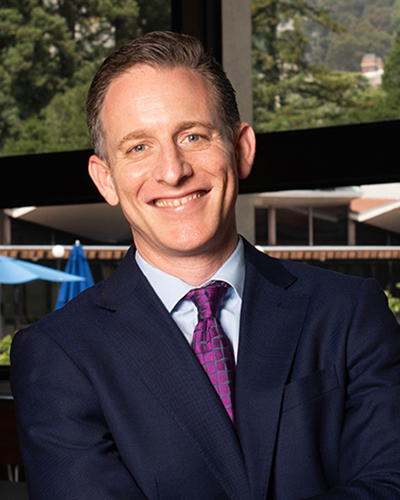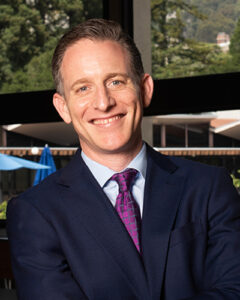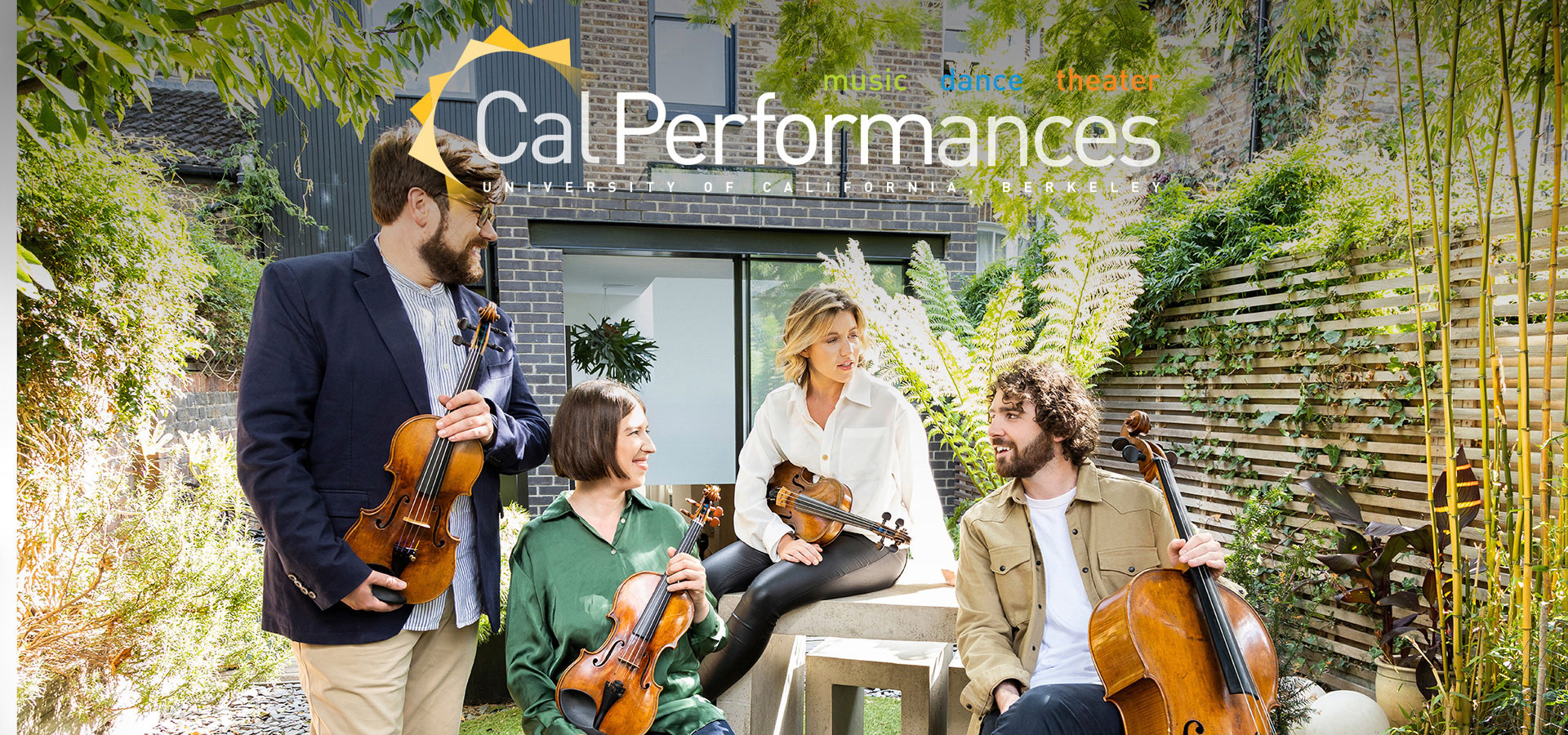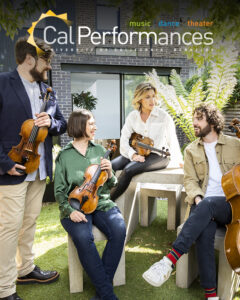Castalian Quartet
Sunday, March 19, 2023, 3pm
Hertz Hall
This performance is made possible, in part, by the E. Nakamichi Foundation.
Run time for this concert is approximately 1 hour and 30 minutes, including intermission, but not including any possible encores.
From the Executive and Artistic Director

It would be hard to exaggerate the depth and breadth of Cal Performances’ programming this month, a schedule distinguished by the culmination of our season-long, campus-wide residency honoring the visionary work of South African artist William Kentridge—the man the UK’s Guardian described as “continuously original, deeply humane, and vividly thought-provoking…one of the great artists of our time.” Residency events include the US premiere of Kentridge’s musical and theatrical work SIBYL at Zellerbach Hall (for more, see Thomas May’s excellent article, beginning on the next page), including a special gala honoring the artist; a presentation of the Dadaist poem Ursonate, performed by Kentridge himself; a staging of A Guided Tour of the Exhibition: For Soprano and Handbag, a bold and innovative work created by Kentridge and Joanna Dudley (who will also perform it); a retrospective of Kentridge’s films; the visual lecture To What End; and classroom conversations. We’re thrilled to play a major role in this extraordinary artistic endeavor and thank our partners—the Berkeley Art Museum and Pacific Film Archive (BAMPFA) and the Townsend Center for the Humanities—for their contributions to this great celebration.
During any other month, the Kentridge Residency would be more than enough to trumpet. But March at Cal Performances will also see a return engagement by the storied Vienna Philharmonic Orchestra, under conductor Christian Thielemann (making his Bay Area concert debut). Over the course of three programs at Zellerbach Hall, the orchestra will traverse a century of canonic repertoire—from the heroic music of Viennese classicism, through several generations of opulent Austro-German Romanticism, to the expanded sonorities of the Second Viennese School near the turn of the 20th century. These works showcase the mighty Vienna musicians at their finest, artists renowned for playing both “rich in detail and fearsome in its intensity” (The Guardian).
If all of this weren’t enough, we’ll also see a long-anticipated visit by New Orleans’ legendary Preservation Hall Jazz Band celebrating its 60th anniversary this year with a rousing program of traditional jazz, gutbucket funk, Afro-Cuban rhythms, folk, and pop; and a performance of Handel’s great oratorio Solomon (1748) with the renowned English Concert, the Clarion Choir, and an impressive array of guest vocalists. Our great friend Zakir Hussain returns with his ever-popular Masters of Percussion; the London-based Castalian Quartet makes its Cal Performances debut with a program that ranges from Haydn to Schubert to a haunting 2006 work by contemporary Finnish composer Kaija Saariaho; and we’ll cap off the month with concerts by the international all-woman jazz supergroup Artemis and the accomplished Zurich Chamber Orchestra with music director and violinist Daniel Hope.
Upcoming Illuminations: “Human and Machine” programming (much of it presented in conjunction with the Kentridge Residency) will continue to take advantage of Cal Performances’ unique positioning as a vital part of the world’s top-ranked public university. As we’ve done all
season long, we’ll be engaging communities on and off campus to examine the evolution of tools such as musical instruments and electronics, the complex relationships between the creators and users of technology, the possibilities enabled by technology’s impact on the creative process, and questions raised by the growing role of artificial intelligence in our society.
Please make sure to check out our brochures and our website for complete information about upcoming events. And stay tuned in April, when we announce our 2023–24 season; we’ve got plenty of exciting news for you.
Thank you for joining us at Cal Performances!
Jeremy Geffen
Executive and Artistic Director, Cal Performances
 It would be hard to exaggerate the depth and breadth of Cal Performances’ programming this month, a schedule distinguished by the culmination of our season-long, campus-wide residency honoring the visionary work of South African artist William Kentridge—the man the UK’s Guardian described as “continuously original, deeply humane, and vividly thought-provoking…one of the great artists of our time.” Residency events include the US premiere of Kentridge’s musical and theatrical work SIBYL at Zellerbach Hall (for more, see Thomas May’s excellent article, beginning on the next page), including a special gala honoring the artist; a presentation of the Dadaist poem Ursonate, performed by Kentridge himself; a staging of A Guided Tour of the Exhibition: For Soprano and Handbag, a bold and innovative work created by Kentridge and Joanna Dudley (who will also perform it); a retrospective of Kentridge’s films; the visual lecture To What End; and classroom conversations. We’re thrilled to play a major role in this extraordinary artistic endeavor and thank our partners—the Berkeley Art Museum and Pacific Film Archive (BAMPFA) and the Townsend Center for the Humanities—for their contributions to this great celebration.
It would be hard to exaggerate the depth and breadth of Cal Performances’ programming this month, a schedule distinguished by the culmination of our season-long, campus-wide residency honoring the visionary work of South African artist William Kentridge—the man the UK’s Guardian described as “continuously original, deeply humane, and vividly thought-provoking…one of the great artists of our time.” Residency events include the US premiere of Kentridge’s musical and theatrical work SIBYL at Zellerbach Hall (for more, see Thomas May’s excellent article, beginning on the next page), including a special gala honoring the artist; a presentation of the Dadaist poem Ursonate, performed by Kentridge himself; a staging of A Guided Tour of the Exhibition: For Soprano and Handbag, a bold and innovative work created by Kentridge and Joanna Dudley (who will also perform it); a retrospective of Kentridge’s films; the visual lecture To What End; and classroom conversations. We’re thrilled to play a major role in this extraordinary artistic endeavor and thank our partners—the Berkeley Art Museum and Pacific Film Archive (BAMPFA) and the Townsend Center for the Humanities—for their contributions to this great celebration.
During any other month, the Kentridge Residency would be more than enough to trumpet. But March at Cal Performances will also see a return engagement by the storied Vienna Philharmonic Orchestra, under conductor Christian Thielemann (making his Bay Area concert debut). Over the course of three programs at Zellerbach Hall, the orchestra will traverse a century of canonic repertoire—from the heroic music of Viennese classicism, through several generations of opulent Austro-German Romanticism, to the expanded sonorities of the Second Viennese School near the turn of the 20th century. These works showcase the mighty Vienna musicians at their finest, artists renowned for playing both “rich in detail and fearsome in its intensity” (The Guardian).
If all of this weren’t enough, we’ll also see a long-anticipated visit by New Orleans’ legendary Preservation Hall Jazz Band celebrating its 60th anniversary this year with a rousing program of traditional jazz, gutbucket funk, Afro-Cuban rhythms, folk, and pop; and a performance of Handel’s great oratorio Solomon (1748) with the renowned English Concert, the Clarion Choir, and an impressive array of guest vocalists. Our great friend Zakir Hussain returns with his ever-popular Masters of Percussion; the London-based Castalian Quartet makes its Cal Performances debut with a program that ranges from Haydn to Schubert to a haunting 2006 work by contemporary Finnish composer Kaija Saariaho; and we’ll cap off the month with concerts by the international all-woman jazz supergroup Artemis and the accomplished Zurich Chamber Orchestra with music director and violinist Daniel Hope.
Upcoming Illuminations: “Human and Machine” programming (much of it presented in conjunction with the Kentridge Residency) will continue to take advantage of Cal Performances’ unique positioning as a vital part of the world’s top-ranked public university. As we’ve done all
season long, we’ll be engaging communities on and off campus to examine the evolution of tools such as musical instruments and electronics, the complex relationships between the creators and users of technology, the possibilities enabled by technology’s impact on the creative process, and questions raised by the growing role of artificial intelligence in our society.
Please make sure to check out our brochures and our website for complete information about upcoming events. And stay tuned in April, when we announce our 2023–24 season; we’ve got plenty of exciting news for you.
Thank you for joining us at Cal Performances!
Jeremy Geffen
Executive and Artistic Director, Cal Performances
About the Performance
Haydn, Saariaho, and Schubert:
Quartets from Three Centuries
That the top of the cover page of one of the first print editions of Joseph Haydn’s Op. 20 set of string quartets was decorated with the image of a rising sun—hence the nickname “Sun Quartets,” which is sometimes encountered—has always seemed emphatically appropriate. Through the cogency of his invention and architectural vision in these works, Haydn proclaimed the birth of a new day for this form of chamber music. The example that the Castalian Quartet has chosen to open their program, published as the fourth in the Op. 20 six-pack, characteristically upends conventional expectations through adventurous detours and games of harmony and time.
The Castalians then fast-forward to our own century to present Finnish composer Kaija Saariaho’s contribution to the string quartet medium. Her arresting Terra Memoria deploys a far wider array of string techniques and textures than Haydn, but they share an underlying goal of intimate communication. The composer’s website describes her music as “not a working out of abstract processes, but an urgent communication from composer to listener of ideas, images, and emotions.”
Legend holds that Franz Schubert requested a special private performance of Beethoven’s Op. 131 just days before his premature death in 1828—the year following Beethoven’s own death—and was moved to exclaim: “After this, what is left for us to write?” But the world would not know for decades of the towering masterpiece Schubert himself had already created with his String Quartet in G major, which fills out our program.
Invention and Contrast:
Haydn’s Quartet in D major from Op. 20
“We had some exquisite quartets by Haydn, executed in the utmost perfection,” observed the English music historian and composer Charles Burney about a visit to Vienna in 1772. That was the year in which the composer, then 40 years old, composed his Op. 20 set of six string quartets. Their publication two years later, in Paris, represents a milestone in the history not only of the string quartet but of Western music itself, according to Sir Donald Tovey, who famously declared that “there is perhaps no single or sextuple opus in the history of instrumental music which has achieved so much.”
Haydn had experimented with the medium in the second half of the 1750s but then put it aside until the 1770s, when he focused intensively on its potential in the Op. 9, Op. 17, and Op. 20 sets (all composed between c. 1769 and 1772); another hiatus of nearly a decade separated this explosion of creative energy from the ensuing set of quartets (Op. 33, heralded by the composer as representing “a completely new and special style”). Haydn was employed at the time by the fabulously wealthy Prince Nikolaus Esterházy I, but, according to the musicologist James Webster, there is no documentary record of string quartet performances at the court per se, so he may have written these three batches for admirers in Vienna. The quartets would play a crucial role in spreading his name internationally.
Invention and impactful contrasts are hallmarks of the Op. 20 set, which encompasses exuberant high spirits and somber intensity, with two of the quartets written in minor keys. The Quartet in D major itself juxtaposes deep reflection with comic, off-beat romping in the second and third movements, respectively. The opening surprises with its softness, even reserve, but is soon kicked into an extroverted mood of vigorous virtuosity. Haydn of course generates engaging drama from this inherent tension and from false-flag gestures such as the prolonging of the moment of recapitulation. These feints send us down one rabbit hole after another of musical development.
The second movement, unusually headed “Un poco adagio affettuoso,” shifts to the minor and presents a set of variations. In this case, the theme that is varied is in itself so astonishingly beautiful that Haydn’s ability to uncover so many more facets becomes a tour de force of creative invention. (Note, for example, the cello’s starring role in the second variation.) The coda’s depth of feeling anticipates something of the Romantic spirit to come. The outburst of vital energy in the minuet is almost jarring in its contrast, but at the outset Haydn actually recycles the same four notes he had used for the slow movement’s theme (now in the major key) to suggest these are two sides of the same coin. The metrical invention in this third movement is especially playful in its syncopated romping, setting the stage for the finale’s scintillating comedy and high jinks. The four musicians ensemble sing, dance, and even giggle—and, to top it all off, lose their voices in the end.
Of Matter and Memory:
Saariaho’s Sonic Poetry
The music world is celebrating the 70th birthday of Kaija Saariaho this season—she reached that milestone in October—but the Finnish composer is not one to rest on her accumulated laurels. Cal Performances audiences who attended the 2015–16 season had a chance to sample the variety of her inspirations when Saariaho was featured in a residency that included concerts, master classes, and conversations. Her oeuvre ranges from intimate chamber works to trailblazing operas, including the recent Innocence, a searing drama involving gun violence that will receive its Bay Area premiere at San Francisco Opera in June 2024. Her debut opera from 2000, L’amour de loin, became the second work by a woman to be staged in the history of the Metropolitan Opera.
Saariaho is driven by the artist’s desire to communicate, but she simultaneously possesses the determined curiosity of a scientist in her investigations of sonic textures and possibilities. Collaborating with fellow artists at IRCAM, the musical research center established by Pierre Boulez in Paris (which she has made her home since 1982), Saariaho experimented early on with electronic-acoustic hybrids. She was influenced by the approach to instrumental timbre pioneered by IRCAM’s so-called “Spectralist” composers, who used computer analyses of the complex array of sounds produced by a particular tone or chord.
In Saariaho’s compositions—which, like Terra memoria, sometimes create the illusion of electronics through purely acoustic instruments—sounds sometimes seem to hover and shift about the listener like a mobile sculpture and acquire an uncanny, ghostlike tangibility even as they evoke the aura of unstable mirages. Her music is intensely mindful of the implications of resonance, even of the relative weights of sound textures.
These implications permeate Terra Memoria, her second work for the string quartet medium. Her first, Nymphéa, dates from 1987 and was inspired by the image of a water lily floating on a liquid surface. It incorporates her spectralist analysis of the sounds of the cello and uses live transformations through electronics of the music generated acoustically by the string players. Almost two decades later came the request to write a piece for the Emerson Quartet, which was commissioned by Carnegie Hall, resulting in Terra Memoria. The Emersons gave the premiere on June 17, 2007; Saariaho subsequently created a version for string orchestra.
The ways in which sounds come into being and fade back into non-existence hold endless fascination for Saariaho. Music involves a process of making sense of this phenomenon through memory. Terra Memoria inscribes into its title—the Latin words for “earth” and “memory,” respectively—this cycle of tangible reality and its lingering presence. The composer dedicates it “to those departed.” She explains: “We continue remembering the people who are no longer with us; the material—their life—is ‘complete,’ nothing will be added to it. Those of us who are left behind are constantly reminded of our experiences together: our feelings continue to change about different aspects of their personality, certain memories keep on haunting us in our dreams. Even after many years, some of these memories change, some remain clear flashes which we can relive.”
Saariaho’s reflections influenced her treatment of the musical material. “Some aspects of it go through several distinctive transformations, whereas some remain nearly unchanged, clearly recognizable,” the composer writes. The title Terra Memoria encapsulates the relationship: the material itself is represented by her concept of “earth,” or corporeal reality, while its treatment and transformation take on the role of “memory.”
The piece unfolds in interlinked sections designed in arch form, beginning and ending at the edge of audibility. The musicians are instructed at the beginning to play “extremely softly … as if the music had been continuing already for a while, but we start hearing it, gradually, only now.” Saariaho’s nuanced instructions incorporate a vast array of string techniques and sound modifications of the instruments and the ensemble texture. The composer writes: “I love the richness and sensitivity of the string sound and, in spite of my spare contribution to the genre, I feel when writing for a string quartet that I’m entering into the intimate core of musical communication.”
Symphonic in Scope:
Schubert’s Great Final Quartet
Schubert had been a prolific writer of string quartets when he was a teenager. But these early efforts were mostly trial works or were intended for the comfortable ritual of domestic music-making: a string quartet made up of family members was fond of playing for themselves and friends, with the composer joining in as violist (the same “insider view” preferred by Mozart). Apart from a projected quartet in 1820 (only one movement of which, known as the Quartettsatz, was completed, even though it is known as his Quartet No. 12), Schubert composed no more string quartets until 1824, when he produced the first two of his final three quartets in close succession: Rosamunde (No. 13) and Death and the Maiden (No. 14).
Another pause followed, and in June 1826—over an astoundingly short period of 10 days—Schubert wrote the String Quartet No. 15 in G major, which carries no nickname. It was not performed in public during the composer’s remaining two years of life and was the last of the final three to be published, appearing in 1851; indeed, all of Schubert’s quartets, save the Rosamunde, were published posthumously. It is of the same vintage as Schubert’s expansive Piano Sonata in G major, D. 894, which he completed in October of 1826; he is also believed to have completed the Great Symphony in C major in the spring or summer of that year. In each of these works, Schubert seems intent on pursuing new, daring, ambitious paths.
The extended proportions of this quartet, as well as the muscular style of its string writing (resulting in notably “big” sonorities), give the composition a sense of symphonic scope. The opening movement, above all, is enormous. Its duration can vary considerably, depending on whether the exposition repeat is followed and, of course, on tempo choices. Overall, the movement “may be regarded as epic or novelistic—in the sense used by Theodor W. Adorno in his book on Mahler,” wrote the musicologist Carl Dahlhaus.
The most immediately striking gesture is the modal ambiguity introduced in the very first measures, with their sudden shift from major to minor. This shift, more than any thematic “cell,” is the kernel of the G major Quartet and its signature—indeed, the signature of Schubert’s unique sensibility. Given the contemporaneity of Beethoven, together with the magnetic influence the older composer wielded over Schubert, many commentators have compared and contrasted the significance of such modal opposition as used by both composers.
Beethoven, in his “heroic” mode, deploys it with a clear narrative purpose to trace a pattern of “victory” over the troubling implications of the minor. His Fifth Symphony, for example, might be characterized as “optimistic” in the most basic sense that the future is revealed to improve over the past. But Schubert repeatedly equivocates between the modes. Unlike the intensification Beethoven requires, the feeling is closer to the unpredictability of real life.
The Andante is particularly disturbing in its dislocations of the lovely elegy in E minor with which it begins. Schubert’s writing here at times verges on an avant-garde attitude. As in the first movement, tremolos are a significant part of the texture. The sense of agitation that these tremolos stir up puzzled Dahlhaus, who wrote that it “hardly seems suited to the idea of epic composure.”
If the lighter scoring of the Scherzo seems to provide mere relief, its contrasting trio merits special attention as the work’s rare oasis of composure—not epic, to be sure, but soul-restoring. It gives the modal oscillation between major and minor, which returns full force in the finale, an even fiercer, more unsettling character. Like the corresponding movement of the D minor Quartet, Death and the Maiden, this one assumes the aspect of a wild tarantella, the frenzied dance from southern Italian folklore.
—Thomas May
Thomas May is a writer, critic, educator, and translator. Along with essays regularly commissioned by the San Francisco Symphony, the Juilliard School, the Ojai Festival, and other leading institutions, he contributes to the New York Times and Musical America and blogs about the arts at www.memeteria.com.



